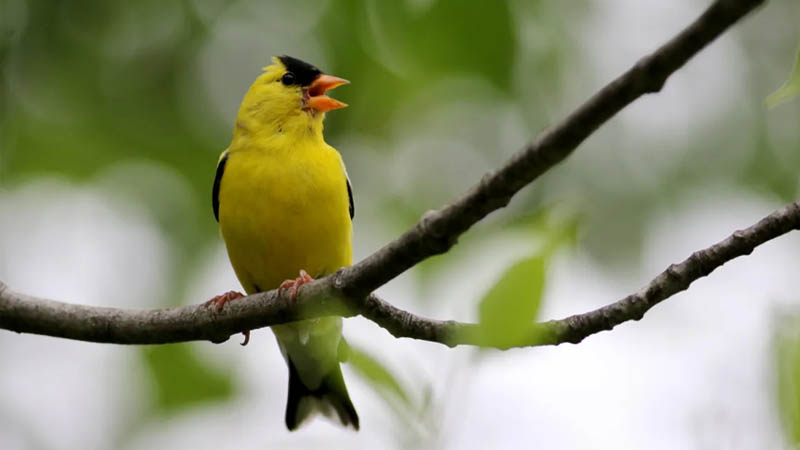American Goldfinch
Spinus tristis (Gmelin 1789)

Appearance
Adult males and females look quite different. In spring and early summer the males are brilliant bright yellow with black forehead, black wings with white markings, and white patches both above and beneath the tail. Adult females are a good bit duller yellow beneath, olive above. Winter birds are drab, unstreaked brown, with blackish wings and two pale wingbars.
Size: L 5″
Shape: Slender, small finch that is somewhat small-headed with a fairly long, notched tail and short conical bill.
Adult Male Spring/Summer: Bill orange; black cap includes lore, forehead, and crown; body color varies from bright yellow to almost yellowish-orange; white undertail and uppertail coverts; black wings with worn white tips; lesser coverts partly to entirely yellow; median coverts white-tipped; greater coverts white- tipped; white covert tips create the appearance of 2 white wingbars, sometimes hard to see because the lesser coverts may obscure the median coverts; tail black with white patches on inner webs of tail feathers that extend to tip of tail; legs and feet pinkish-brown.
Adult Female Spring/Summer: Brighter than in nonbreeding plumage; bill orange; greenish-yellow crown; dusky yellow upperparts and yellow underparts; whitish uppertail and undertail coverts; dark-brown wings with worn white edges; lesser coverts brown; median and greater coverts white-tipped, producing wingbars; tail dark brown with white patches on inner webs of tail feathers that extend to tips; legs and feet pinkish-brown.
Adult Fall/Winter: Variably pale grayish to brownish-yellow; white undertail coverts; dark gray bill.
Adult Male Fall/Winter: Some bright yellow on throat; lesser coverts yellowish; black wings with whitish wingbars.
Adult Female Fall/Winter: Lesser coverts olive; dark-brown wings; whitish or buff wingbars.
1st Year: Like adults in each season, up to 10 inner greater wing coverts are replaced and darker with broader whitish tips.
Juv: (July–Oct.) Brownish-yellow; dark-brown wings with wide buffy wingbars and edges to tertials and secondaries; whitish undertail coverts. Males with slightly darker wings than females; yellow on male’s throat gets brighter with age.
Natural History
The American Goldfinch is an abundant and widely distributed species across much North America. Highly granivorous, with strong preference for seeds of Compositae.
Taxonomy
S. t. tristis (Linnaeus, 1758): (breeds cent. ON–e. CO to Nfl–SC, winters to TX–FL) medium-sized: sum- mer m. with extensive black cap and bright yellow body
S. t. pallidus Mearns, 1890: (breeds interior s. BC–NV to w. Ont–w. NE winters to AZ–TX) larger: more brown-olive on upperparts, summer m. smaller cap.
S. t. salicamans Grinnell, 1897: (breeds and winters coastal s.w. BC–n.w. Baja CA) small: darker, browner, summer m. pale yellow with smaller black cap. Birds breeding in s.w. BC–s.w.
S. t. jewetti (van Rossem, 1943): (“jewetti”) may be browner; pallidus (breeds interior s. BC–NV to w. Ont–w. NE winters to AZ–TX) larger: more brown-olive on upperparts, summer m. smaller cap.
Object of study
Irruptions across southern States, and if it engages in mimicry at all.
Flight Call
The tsee-tsi-tsi-tsit (or po-ta-to-chip) flight call is the most widely used vocalization. Flight calls not easily confused with other finches. Flight call, like with other finches, functions to locate and maintain auditory contact with mate and/or flockmates.
Irruptions
Not known to be highly irruptive, but wintering numbers can fluctuate from year to year in the very southern part of its range in Georgia, Florida and Louisiana.



